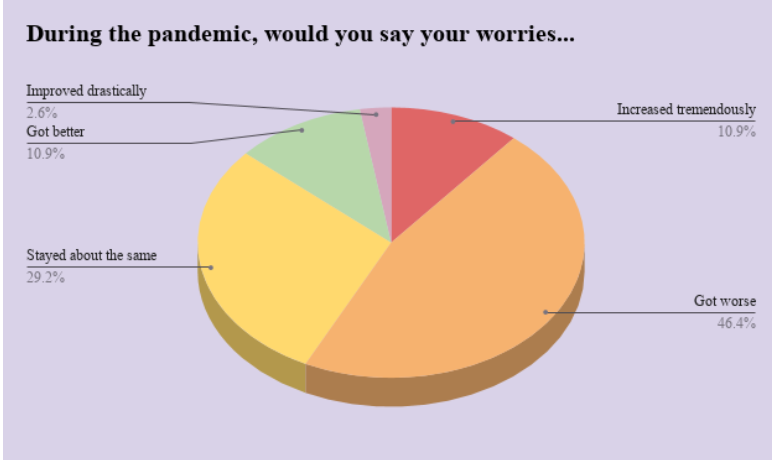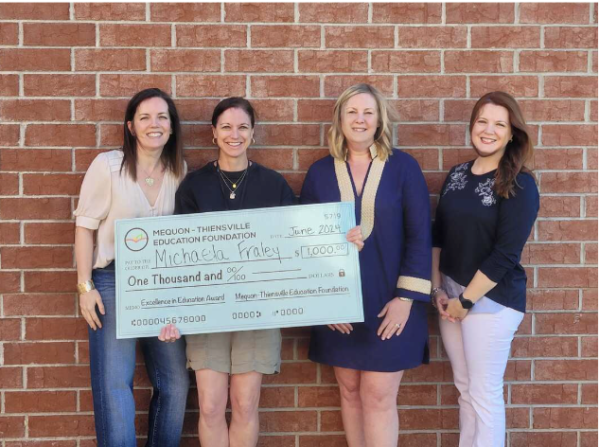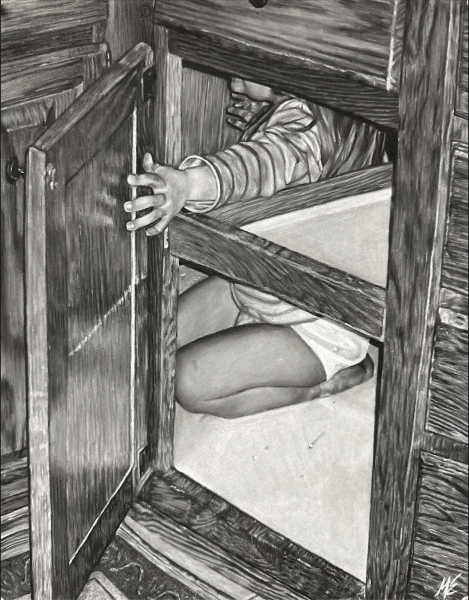Pandemic distress impacts teen mental health
It is probably no surprise that the isolation from the pandemic has had impacts on the mental health of youth, who mostly thrive in socialization with peers.
In fact, coupled with the other COVID-19-related distress, in a survey of 192 Homestead students, almost half report that their worries resulting from the pandemic have gotten worse, with almost 11% of them claiming their anxiety has increased tremendously.
Students said that their disturbances have revolved around a combination of various factors influenced by the pandemic, including struggles regarding finance, family, relationships, academics, college admissions, the virus itself, their physical health, politics and the general state of the current and future world.
Despite the decreased mental well-being for many within the school, 89% of students report never having used any Homestead services for aiding their mental health or stress levels, and only 1.2% ever plan on doing so.
Tahlia Jordan, sophomore, reported feeling hopeless when adjusting to the new school environment. “Going back to school was the most ridiculous thing[…] the amount of homework that we had to do was so stressful…they started using new programs, assigning more homework, and in each class you have to have like eight tabs open and had a different time/day schedule,” Jordan said.
Currently learning virtually, Alicia Forier, senior, said that as a new student to the district, she can “feel very cut off from teachers and peers… I have the drawback of not knowing anyone, and being in a new environment with very different circumstances than what I was used to. I haven’t made friends, mostly because I haven’t really been able to leave the house…a lot of times, I just internalize everything and I cut others off so I can try to deal with my problems myself,” Fourier said. “The best advice I ever got was It won’t get better unless you do something to make it stop. You’re the only one who has the power, so use it and make your life better and it has stuck with me,” Fourier said.
So how exactly can people improve their quality of life during such uncertain times?
Terry Carr, LCSW, LSSW and HHS emotional coach, recommends controlling what you can control. “What I would advise to students is to stay as involved in activities as they can…trying to keep to a schedule and to be mindful of their thoughts and feelings,” Carr said. “Family is huge in their influence on a teen’s mental health… trying to spend time together is important. Being with family at meals and everyone being away from phones and computers has helped some students a lot… even pets have been a huge support.”
Carr said that she has personally seen a shift in the psychological well-being of students during 2020 and 2021 in comparison to earlier years.
While there has been an “increase in resiliency,” Carr said, “there is increased anxiety… with the constant change and inconsistency in our lives, especially given that stress reduction is not as easy, with many of the activities [students] have relied on being cancelled.”
Nanci Shiman, advanced practice and licensed clinical social worker in the Mequon community, said the true depths of what it means to be a teenager in society today, exemplifying what teens, families and schools can do to help counteract the increasing distress.
“In the past year the incidence of depression and anxiety has gone from 11% up to 56% among young adults, and resultantly, we have seen a steadily growing demand for mental health services, particularly in the last two months as we near the one year mark of the pandemic… and it is becoming more and more difficult to accommodate new clients because our schedules are full,” Shiman said.
“I started thinking ‘I am never gonna have a future; college is no longer an option; friends don’t care about me anymore’. It felt like I was drowning, reaching my hand up above the water waiting for someone to catch me, but no one did. And I sunk, losing all motivation and energy to swim and to keep going. It’s such a terrible feeling, and the fact that it would have easily been avoided if someone would just think of the consequences before jumping into a new way of schooling…but even if I’m in a better place mentally, it doesn’t mean it’s the same for other students,” Jordan said.
To this she provided possible ideas for improvement: “a quiet place for students to work and think, having homework be only less than an hour, email students privately if they are not doing their work to check in on their well-being, learning about healthy coping mechanisms and better education about mental health in school,” Jordan continued.
“Supporting ways for teens to stay connected with peers is very important, as with talking about stressors and how we feel (which can be helpful in normalizing emotions which tend to feel isolating and unique), being active (as physical activity produces endorphins (think ‘runners high’) that naturally counteract stress and can redirect our thoughts), practicing mindfulness meditation and asking for help,” Shiman recomendends to people aiming to improve their psychological well-being recently.
While additional research is needed to assess the short and long-term mental health effects of the COVID-19 pandemic, there is no question that it has “surged levels of a complex array of factors, including social isolation and uncertainty,” an article by the Psychiatric Times reports.
The stabilizing force of predictability for younger people has been disrupted since the COVID-19 outbreak, and a total of 63 studies including 51,576 participants by the U.S. National Library of Medicine and National Institutes of Health has proven that “loneliness, (more often its duration than its intensity) has increased the risk of depression nine years later,” probing the question of whether these findings can be attributed to circumstances similar to quarantines, and if they have potential implications for the COVID-19 pandemic.
From empty bleachers to mask coverings, the ongoing ramifications of the COVID-19 pandemic are often blatantly obvious in society; however, the questions remain: are these effects just the tip of the iceberg with so many other consequences hidden from visibility?
The pandemic has brought forth the time for bonding with close family, self care and possibly learning to have gratitude and thrive in simplicity. However, with the various alterations to daily living, many within the youth generation have seen their teen years flip upside down, as their socialization reaches miles farther than six feet apart.
“Everybody thinks of us as less than human. Like we can’t do what everyone else can, which is false. It’s so crucial to be compassionate to everyone, regardless of who it is, because acceptance and empathy heal and connect everyone. We must celebrate everyone’s individual strengths, then we will see how there is so much possible growth and unity that can come from the diversity of people.“ Jordan said.

Of 192 students, 46.6% report that their worries have gotten worse from the pandemic, 10.9% say they have increased tremendously, and only 2.6% have said that their worries have actually improved drastically, meaning only 13.5% have had any improvement in their anxiety at all.

Sofia Grbic is currently a sophomore at Homestead high school. She has always had passions for creativity, learning, and adventure. She immensely enjoys...





